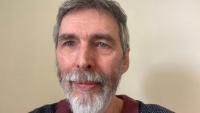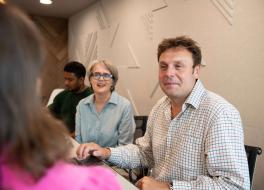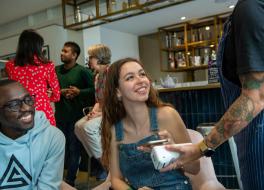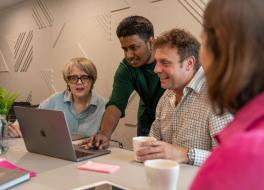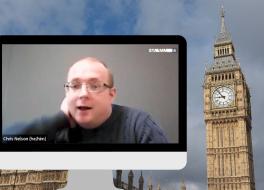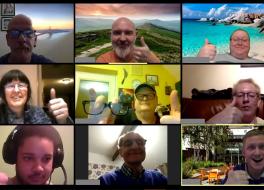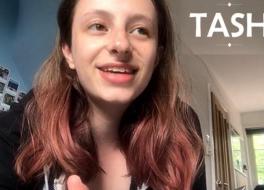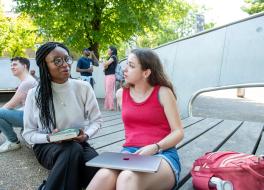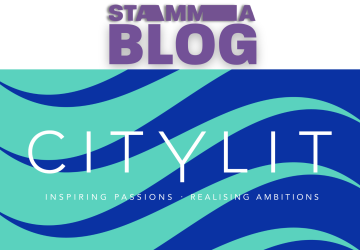

Blog: Pride Against Prejudice
20th September 2023
Our Web Editor Steven reports back from 'Stammering Pride Against Prejudice: Creating Stammering Culture & Identity' at City Lit on Friday 15th September.
"Today we're going to be honouring stammer time," announced co-host/organiser Sam Simpson to the packed-out theatre at London's City Lit as she opened proceedings. No, she wasn’t about to break out into a rendition of 'Can't Touch This' by MC Hammer (sadly... I would've loved that). Instead she was making it clear that time constraints wouldn't stop speakers from saying what they wanted to say, stammer or not. 'Stammering Pride Against Prejudice' was going to be a day to explore and celebrate stammering culture and identity, and to hear the stammered voice unfiltered. That we certainly did over the next seven hours of talks, discussions and chats.
First up to speak was Maria Stuart from University College Dublin. Maria explained how stammering became medicalised in the 19th century and seen as something to be ‘cured’, and how political and economic models have conditioned society's responses to it. She put forward new ways to look at stammering; counter-narratives from academics like Chris Constantino who finds moments of joy and delight in an unexpected stammer, and talks of 'stuttering gains' — positive things it can give us.
Intersectionality
Next up, Derek Daniels flew over from USA's Wayne State University to speak about how peoples' different identities intersect, overlap and shape their experiences of stammering. Derek talked about his own experience as a gay black man who stammers and highlighted quotes from people involved in his research, including this from a man who feels he stammers more with fellow African Americans: "I feel like I have to show a strong version of myself without weakness". A quote from someone else said that it was easier to accept being gay than it was their stammer. The upshot: people don't experience things in the same way — we need to better understand that so we can better help people who stammer.
Article continues below...

Derek explored intersectionality further, chairing a panel discussion with Amy, Joe, Ramdeep and Katy. Amy told us about the microaggressions she experienced when training to be a speech & language therapist. When someone complimented her on her ‘lovely fluency’, it made her feel that her stammering is wrong. Joe then spoke about the experience of being transgender and how people stopped seeing his stammer and instead focused on his trans identity, like there's a hierarchy of stigmas.
Someone from the audience posed the question: is there a risk that intersectionality would make the community splinter off and dilute the concept of stammering pride, in the same way it has in other movements? Derek didn't think so and said that if people feel welcomed and if there's a space for them, it will increase engagement in the wider community.
Movements, art & flags
After a lunch with lots of opportunities to chat, Keynote speaker Joshua St Pierre from Canada's University of Alberta talked about movements that have challenged the notion of disability as something to be cured. For instance, how the insult 'crip' has, not without controversy, been reclaimed and used by some in the disability community to rebel against ableist attitudes and prejudice. He spoke of Mia Mingus, an educator on disability justice who's written about 'inclusion for the sake of inclusion' and how "access should be more than simply adding a ramp or providing captions, but done in the service of love, justice, connection and community… to ensure the inaccessibility doesn't happen again". See Mia's blog post '“Disability Justice” is Simply Another Term for Love'.
Dysfluent art was explored next, with a panel of people showing how they express their stammering experiences artistically. Paul Aston spoke about capturing the moment of stammering in a self-portrait and designer Conor Foran introduced his magazine 'Dysfluent' that showcases stammered voices. Willemijn Bolks showed some of her comic strips that express her range of feelings (check them out on Instagram: @juststutter). She mentioned 'toxic positivity' at one point, which was really interesting — recognising that it's okay not to always feel positive about your stammer. That was a sentiment brought up later, when Nora Trench Bowles from the Irish Stammering Association said that 'Stammering Pride' shouldn’t mean having to feel proud all the time — she argued that you can be proud sometimes and not feel great on others; there shouldn't be any pressure to be either/or.
U.S. Musician JJJJJerome then told us how stammering helps him connect with nature, talking to trees and not holding back. Afterwards, someone remarked to me that listening to JJJJJerome speak is almost meditative. He fearlessly resists any pressure to hurry his speech and insists that the listener hears his authentic voice. There was a moment when he blocked and the audience sat in silence for a full minute hanging on his every word. It was like he was both inviting and challenging us to be in that moment, that space, to break through any discomfort, and share and experience it together.
The Stammering Pride flag, created by the Stammering Collective, was then unfurled and presented to the audience, with co-host Patrick Campbell explaining what it represents. Why a flag? Bracelets are passive, he explained, while flags are more active: "you go into battle with a flag".
The rest of the afternoon was devoted to people sharing their wide-ranging experiences. Lorraine Maher-Edwards confessed being worried that she shouldn't be here and wouldn't have anything of value to say because she goes through patches where she doesn't stammer. This was really interesting — how can we make those who may not see themselves as fully part of the community, because they don’t always stammer, feel included? Jack — who wrote a Your Voice article about preparing for the event — was great too and explained to the audience how seeking to learn more about Stammering Pride ideas helped him.
Ideas
The day was about sharing ideas too. Ideas about how to feel differently about our stammers and change things in society. Getting together and talking was a suggestion that came up again and again as the way forward. In the intersectionality discussion, Joe spoke about how engaging with stammer-positive literature and communities created an environment where he could embrace and accept his stammer. Paul Roberts echoed this in his talk about setting up STAMMA Striders, saying that support groups can help begin that journey to acceptance and pride.
It was suggested that we need to be vocal with the outside world too. Ramdeep, who feared he wouldn't be taken seriously as a doctor, said that disclosing his stammer early on, not hiding it and framing it as a positive helped his employers to understand that it was merely something he did. Paul Aston said his self portrait prompted many of his colleagues to ask him about it. Nora spoke about being a guest on popular podcasts in Ireland and advocating by speaking to different audiences. Derek Daniels summed it up when he said there needs to be more opportunities to hear stories; this opens up space for greater understanding, he said.
Not everyone finds it easy to feel proud of their stammer, and Patrick Campbell asked Joshua St Pierre how we can navigate between different attitudes in the community. Joshua suggested inviting those people in and opening a dialogue.
Conclusion
All in all it was a really thought-provoking and inspiring day with a good mix of academic exploration and individual experiences. It was pleasure to hear people being open and sharing their stories and, of course, to chat afterwards over a glass of wine and not have to think about our speech.
The day wasn't about preaching. It was suggesting that there's another way to think about stammering, to try and embrace it rather than struggle with it. To start to think about how it's not 'our fault' if we stammer. We saw a different side to stammering — people getting on in life, being open about it and getting positive responses as a result; being able to express themselves creatively; finding acceptance and change through meeting others and talking; and celebrating our identities as people who stammer.
Let's have more opportunities where we can get together, talk, share experiences and ideas, and learn about each other. Not just events like this, but support and social group meetings too — they're a great place to start the conversation. You can see what's around on our Stammering Groups & Communities page. It has lists of in-person groups, online special interest groups, as well as details of Facebook groups.
City Lit is an adult education centre that runs therapy courses for people who stammer. To see the full range of options available, see our Therapy & Courses section.


